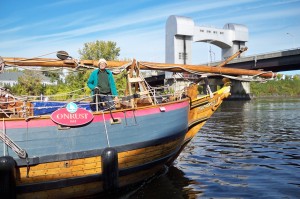One of the reasons we have chosen to go on this sailing trip is to explore another form of transportation, one that has a LONG track record in history, that does not require fossil fuels for power. We feel that in the coming years and decades we may be facing a serious oil shortage that will make our current transportation system impractical and unsustainable. So why not check out another transportation system, the one that was the norm for hundreds of years before cars? And what better day to write about this subject than Columbus Day, the day we commemorate the first explorers to America, who came in boats entirely powered by the wind?
I’ve been reflecting a lot on the history of this area, as we have gone down Lake Champlain, and now the Hudson River, which was where a lot of the major action was going on in the early days of the colonization of this area. The first explorers came this way to look for a passage to China. What would they think now of our trade relationship with China ,which has taken over the production of almost all goods that we currently use? Later, this area was the hotspot for numerous Revolutionary War battles, and then was a major trade and travel route until the trains, and later cars took over. Today we were docked right next to a replica of the “first decked sailing vessel built by Europeans in the New World”. A gorgeous ship, complete with a golden carved lion head on the bowsprit, it was built entirely by volunteers using authentic reproduction tools from the era. It’s amazing to think back on how these early explorers travelled — not only did they not have GPS computers and depth sounders, they didn’t even have maps. They were the map makers. And they were entirely dependent on the wind — no backup motor for them when the wind died down!
One of the other boats docked near us today at the Troy, NY dock, was an enourmous 75 foot modern yacht, basically a floating mansion. We marvelled at how gigantic and luxurious it looked, and speculated how many million dollars it cost. Later we talked to the dockmaster, who had helped them fill up for gas, and he told us that that boat uses a thousand gallons of fuel per day!!! A THOUSAND GALLONS A DAY! That’s $3,000 per day in fuel costs! Just a few days of that, and it would pay for our entire boat! Boats like that average 5 gallons a mile. And we think big SUV’s get bad gas mileage! I can’t help but think that that is bordering on criminal and obscene to use that much fuel just to take a floating vacation. And apparently the owner of that boat is planning on selling it in order to buy a bigger one!
Here aboard the Wee Happy, we purchased 5 gallons of fuel to go 60 miles, which is very good gas mileage for a sailboat. During the most recent portion of our trip we had to exclusively use our motor, because we were going through the Champlain Canal and had to take our mast down in order to get through the locks and under the many low bridges that crossed the canal. Tomorrow we will be putting our mast and sails back up, and are looking foward to sailing the rest of the way down the Hudson River. (although if there is no wind, we will be grateful for our motor!)
How many gallons of fuel will it take us to reach Florida? We aren’t sure yet, (does anyone want to make a bet on how many gallons we will use?) but we are making every effort to make it as few as possible. It will definitely take less than the reported 30,000 gallons of fuel that our megayacht neighbors used to get here from Florida.


